|
|
|
Sort Order |
|
|
|
Items / Page
|
|
|
|
|
|
|
| Srl | Item |
| 1 |
ID:
149891


|
|
|
|
|
| Summary/Abstract |
This article investigates the long-term energy demand and energy policy measures when undergoing structural changes in energy demand. Initially, the statistical test shows the possibility of the structural change from the late 2000s. Therefore, we developed the energy demand model to forecast the energy demand by 2030 that considers the structural change. The results show that there may be a 12% reduction in the energy demand in 2030 compared to the reference case in the Japanese government's outlook, which is equal to about 86.0% of the effect of the planned policy measures by the government, but also that it is difficult to achieve energy-originated CO2 emissions in the national target. Our analysis suggests that mitigation policies are required, but those in the planned policy measures are not completely required to achieve the goal.
|
|
|
|
|
|
|
|
|
|
|
|
|
|
|
|
| 2 |
ID:
111481


|
|
|
|
|
| Publication |
2012.
|
| Summary/Abstract |
This article seeks to develop a conceptual and policy framework for understanding China's role in the global economic imbalances. China's contribution to these imbalances via recurrent trade and financial surpluses corresponds with a phase of deepening structural risks to China's economic growth and development. These structural challenges include: the composition of growth resulting from China's dynamic internal transformation, China's trade orientation, the trajectory of resource use and CO2 emissions, welfare problems relating to distribution and international constraints. This article develops a conceptual framework for examining the relationship between the processes of long-run structural transformation in China, its economic imbalances, and the role of institutional reform in dealing with these structural challenges. As such, economic policy should extend beyond short-term macro management to pursue an institutional reform agenda to facilitate broader structural change to mitigate constraints to future growth and to improve economic welfare.
|
|
|
|
|
|
|
|
|
|
|
|
|
|
|
|
| 3 |
ID:
147434
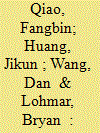

|
|
|
|
|
| Summary/Abstract |
China's hog production has undergone significant structural transition, from the traditional backyard production mode to the large-scale production mode. In this study, we illustrate the linkage between economic development and the transition in hog production mode. Using unique and nationally representative survey data, we find that an increase in farmer wealth motivates them to transition away from backyard hog production. However, the relationship between wealth and herd size among large-scale hog producers is positive. With farmer wealth increasing rapidly, the transition of China's hog production toward the large-scale mode is expected to continue; this will have significant implications for not only hog production, but also the feed sector and many other related sectors.
|
|
|
|
|
|
|
|
|
|
|
|
|
|
|
|
| 4 |
ID:
132409


|
|
|
|
|
| Publication |
2014.
|
| Summary/Abstract |
Several East Asian countries, with scarcely any crude oil, have developed since the second half of the twentieth century strong production capacities in refining and petrochemicals. This has been the case in Japan, Taiwan, Singapore, South Korea, Malaysia, Thailand, Indonesia and China. This paper assesses whether the development of refining and petrochemical industries in these countries may be better understood with the aid of one of the major interpretative paradigms of structural change and foreign relations in East Asia: the Flying Geese Paradigm. The article concludes that, overall, the production and external relations in oil-related industries do indeed follow a Flying Geese Paradigm pattern. We observe, nevertheless, some dissonances that are attributable to the particularities of intermediate sectors (such as refining and basic petrochemistry).
|
|
|
|
|
|
|
|
|
|
|
|
|
|
|
|
| 5 |
ID:
159807


|
|
|
|
|
| Summary/Abstract |
This article presents a quantitative analysis of growth, structural change and employment linkages at the aggregate level and by sector under the state- and market-led regimes in India. The underlying objectives are: (a) to understand how economic liberalization has affected the economic and labour market structures, and linkages thereof; and (b) to analyse how these dynamics have affected the generation of productive employment in the economy. The analysis is based on Shapley decompositions. Our results suggest that the contribution of structural change in employment to growth declined drastically and secularly as the country transitioned to a high-growth regime driven by globalization. The sector-level analysis indicates that employment opportunities are not being created in high-productivity sectors and segments. Thus, despite a high-growth rate in GDP per capita and productivity-enhancing structural transformation in GDP, a vast population is still trapped in employment that cannot be qualified as productive employment. The study attributes it to trade-induced economic specialization accompanied with weakening of internal inter-sectoral linkages. The article makes a strong case for strategic government intervention to broad base structural change for generating productive employment, which is at the core of poverty reduction.
|
|
|
|
|
|
|
|
|
|
|
|
|
|
|
|
| 6 |
ID:
123468


|
|
|
| 7 |
ID:
121306


|
|
|
|
|
| Publication |
2013.
|
| Summary/Abstract |
This study revisits the cointegrating relationship between carbon emission, energy use, economic activity and trade openness for India using threshold cointegration tests with a view to testing the environmental Kuznet's curve hypothesis in the presence of possible regime shift in long run relationship of the variables for the period 1971 to 2008. The article confirms the existence of 'regime-shift' or 'threshold' cointegration among the variables and environmental Kuznet's curve for India. It challenges previous empirical works for India which fail to establish cointegrating relationship among these variables and explains its logical and econometric reasons. The study finds that the carbon emission is highly elastic with respect to real per capita income and energy use in India. This finding is critical and warns successful design and execution of energy and environmental policy framework which would pave the low carbon sustainable growth path inIndia.
|
|
|
|
|
|
|
|
|
|
|
|
|
|
|
|
| 8 |
ID:
137597


|
|
|
|
|
| Summary/Abstract |
Based on the convergence hypothesis and referring to the experience of East Asian high-performing economies from 1950 to 2010, this paper projects and plots the potential growth rate of the Chinese economy over the next 20 years. It predicts that the potential growth rate of per capita GDP adjusted by purchasing power parity averages at 6.02 percent from 2015 to 2035, while the potential GDP growth rate of 2015 would still be above 8 percent, which implies that the realized rate of growth has not reached its potential since 2012. Besides, based on the per capita GDP projected and on cross-country comparison, the paper plots the trajectory of structural change of the Chinese economy from 2015 to 2035. The result shows that: (i) the value-added share of primary industry will drop more rapidly than the employment share; (ii) the value-added share of secondary industry will decline and employment share will present an inverted U shape whose turning point will probably come between 2020 and 2025; (iii) both the value-added and employment share of tertiary industry will increase continuously.
|
|
|
|
|
|
|
|
|
|
|
|
|
|
|
|
| 9 |
ID:
121863
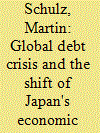

|
|
|
|
|
| Publication |
2013.
|
| Summary/Abstract |
Twenty years of slow growth and depression in Japan had a strong impact on relations with Southeast Asia. An explosion of public debt to 235 per cent of GDP has greatly reduced the ability of Japan's government to manoeuvre and has shrunk its overseas development assistance (ODA) contributions to the lowest levels of major donors. While its population was ageing, markets shrinking, and corporations restructuring, Japan became more inwardlooking. East Asia, at the same time, was catching up and now represents the world's most dynamic market. Today, Southeast Asia is not only the base for Japan-centred production and supply chains, but the focal point of future-oriented market investment. The article will follow the stage of Japan's "lost" decades, its evolving debt crisis, and show why the country will have to focus on much closer integration with Southeast Asia in the future.
|
|
|
|
|
|
|
|
|
|
|
|
|
|
|
|
| 10 |
ID:
168357
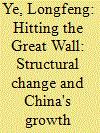

|
|
|
|
|
| Summary/Abstract |
China is facing slowing growth rates, slowing rates of rural to urban migration and resistance to reforms that would liberalize internal migration restrictions (Hukou). We use a two sector Ramsey growth model and show that, allowing for endogenous capital accumulation, labour reallocation has accounted for approximately one fifth of China's per capita GDP growth over the last 30 years, and that Hukou reform could generate a significant boost to China's per capita GDP growth over the next decade. Our results contrast with conclusions drawn from the traditional growth accounting literature on labour reallocation effects in China because our simulation method allows for endogenous capital accumulation dynamics.
|
|
|
|
|
|
|
|
|
|
|
|
|
|
|
|
| 11 |
ID:
193769


|
|
|
|
|
| Summary/Abstract |
Despite the structural change toward services that are generally beneficial for female employment, China's gender employment gap (GEG) has widened by 9.64% in the past two decades, 2000–2020, indicated by the labor force participation rate (LFP) of males minus that of females. This study distinguishes domestic demand and different types of global value chain (GVC) related demand under the inter-country input–output framework, and propose a new gender gap decomposition model to explore the evolution of China's GEG from a demand-side perspective. Our results show that GVC-related activities contributed to the widening of China's GEG by less than 0.60% between 2000 and 2020. In contrast, increasing gender discrimination toward females and technological progress with a rapid decrease in employment when producing the same amount of output in most female-intensive sectors are the dominant reasons behind the widening of China's GEG. This study provides some implications for promoting high-quality employment development in China.
|
|
|
|
|
|
|
|
|
|
|
|
|
|
|
|
| 12 |
ID:
107611
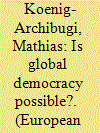

|
|
|
|
|
| Publication |
2011.
|
| Summary/Abstract |
Scepticism about the possibility of a democratically governed global polity is often rooted in beliefs about 'necessary conditions'. Some democracy scholars consider a transition to global democracy to be incompatible with necessary conditions for democratic governance, while some International Relations scholars consider it to be incompatible with necessary conditions for international structural change. This article assesses hypotheses and evidence about democratic transitions within states and transformations in the interaction among states and concludes that arguments based on necessary conditions are not compelling. This suggests that global democracy may be unlikely but it is not impossible.
|
|
|
|
|
|
|
|
|
|
|
|
|
|
|
|
| 13 |
ID:
095220


|
|
|
| 14 |
ID:
163326


|
|
|
|
|
| Summary/Abstract |
This paper studies the relationship between population aging and structural change in terms of employment distribution in the non-agricultural sector. Based on cross-country panel data, it is revealed that a greater share of elderly workers in the labor force is associated with more service employment relative to that in the industrial sector. To rationalize this finding, a two-sector overlapping generations model is constructed. The model highlights two forces, namely the “scale effect (SE)” and the “composition effect (CE)”, that drive the correlation between the labor force age structure and the service-industry employment ratio. Calibrating main model parameters with China's micro level data, simulation results well fit the country's historical trajectory of structural change. According to population forecast data, the model predicts a substantial growth of services relative to the industrial sector in China up to 2050.
|
|
|
|
|
|
|
|
|
|
|
|
|
|
|
|
| 15 |
ID:
140234


|
|
|
|
|
| Summary/Abstract |
Structural change theories usually assume agents are homogeneous. However, because of demand-side or supply-side heterogeneities, the probability of switching among sectors differs across people. This paper reveals these differences through restoring a long-period, individual-level panel dataset from China's Urban Household Survey for 1986–2009. We find that both for people who started working for the first time and those who switched jobs, the sector choice depends on personal characteristics. In particular, women and people with higher educational attainment or a previous white-collar job are more likely to join the tertiary sector and less likely to join the primary sector. These effects are substantial even if the macroeconomic variables used in conventional structural change theories are controlled. They are also robust in various periods and at more detailed industry levels. Our research suggests that it is important to pay greater attention to the labor composition when making policy related to economic structural change.
|
|
|
|
|
|
|
|
|
|
|
|
|
|
|
|
| 16 |
ID:
059762


|
|
|
| 17 |
ID:
110250


|
|
|
|
|
| Publication |
2012.
|
| Summary/Abstract |
This paper examines empirically the Phillips curve relationship for the Chinese economy. We use quarterly data that go back to 1978 and employ a multivariate rather than univariate method in the construction of gap measures for inflation, money and output jointly with reliable error bands. Our empirical results show that the inflation gap and the output gap fit a New Phillips curve very well. We also find some structural change in the inflation-output trade-off.
|
|
|
|
|
|
|
|
|
|
|
|
|
|
|
|
| 18 |
ID:
187423
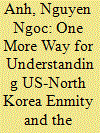

|
|
|
|
|
| Summary/Abstract |
In this essay, we attempt to use Alexander Wendt’s Hobbesian culture hypothesis to examine three aspects of US-North Korea relationship: (i) what kind of relationship it has belonged to, (ii) why it has not changed for over past 70 years, and (iii) what possible relationship between the USA and North Korea will be under the Biden Administration. The results show that Hobbesian culture has been dominating US-North Korea relations since 1949 when the USA did not recognize North Korea’s sovereignty and then launched unlimited war against North Korea in late 1950. Then the difference in internalization of the USA and North Korea to Hobbesian culture generated two opposing goals: while the USA pursues interests created by the existence of Hobbesian culture, North Korea pursues interests generated by the end of this Hobbesian culture. This is the main factor that has prevented a structural change over past 70 years. Theoretically, there may be at least three possibilities to change the structure of US-North Korea relations under the Biden Administration. But our examination of these possibilities show that it is hard for these possibilities to come true. It is suggested in this essay that the USA should try to improve its relations with North Korea by increasing US-North Korea interdependence. Once the interdependence is generated, the external restraint will be created. And when great enough, the interdependence will improve their relation and even create a structural change in the further future.
|
|
|
|
|
|
|
|
|
|
|
|
|
|
|
|
| 19 |
ID:
191128
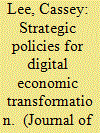

|
|
|
| 20 |
ID:
182719


|
|
|
|
|
| Summary/Abstract |
This paper examines the impact of structural change in China, in particular a reduction in the savings rate, an increase in the share of skilled workers, and an increase in productivity in technologically advanced manufacturing sectors targeted by Made in China 2025. Baseline projections until 2040 are generated with the WTO Global Trade Model, a dynamic computable general equilibrium model. With the modelled structural changes, the Chinese economy is projected to reorient its focus increasingly onto the domestic economy, raising the share of private household and government consumption in GDP, turning China's trade surplus into a trade deficit, reducing China's share in global exports, raising the share of services in both production and exports, shifting the destination markets of Chinese exports from developed to developing countries, and changing its pattern of comparative advantage away from sectors like light and heavy manufacturing to electronic and machinery equipment. The large bilateral trade surplus vis-a-vis the United States is projected to fall to almost zero.
|
|
|
|
|
|
|
|
|
|
|
|
|
|
|
|
|
|
|
|
|